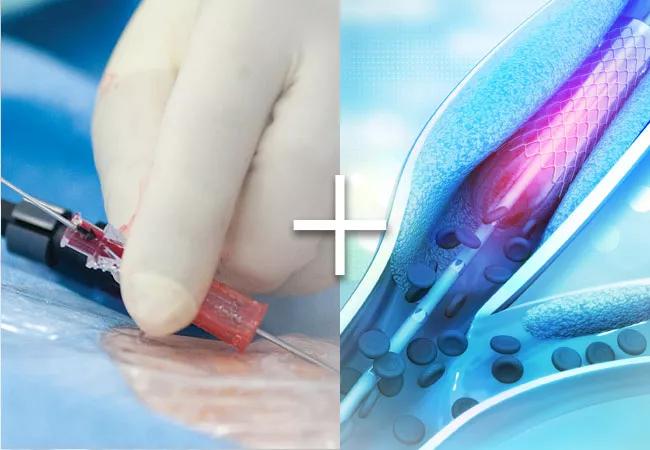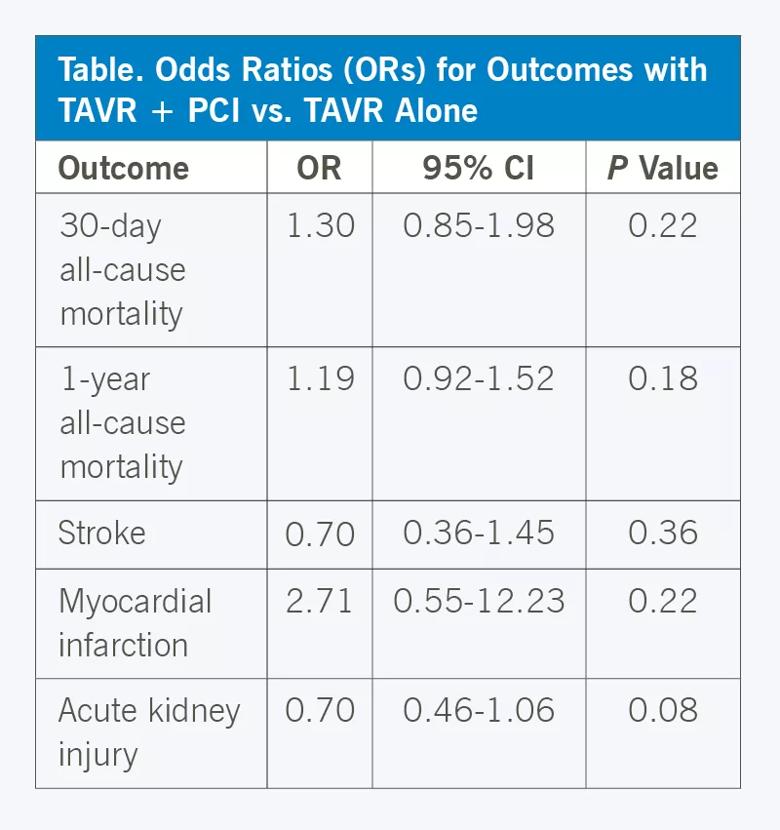Pooled results of 11 observational studies offer needed guidance on PCI in this setting

Percutaneous coronary intervention (PCI) is not associated with improvement or worsening in any major outcomes in patients undergoing transcatheter aortic valve replacement (TAVR), concludes a meta-analysis of 11 published trials presented at the Transcatheter Cardiovascular Therapeutics (TCT) 2019 meeting. The analysis was simultaneously published online in The American Journal of Cardiology.
Advertisement
Cleveland Clinic is a non-profit academic medical center. Advertising on our site helps support our mission. We do not endorse non-Cleveland Clinic products or services. Policy
“It appears that PCI at the time of TAVR does not increase the risk of TAVR,” says the study’s corresponding author, Cleveland Clinic cardiologist Ankur Kalra, MD. “The role of PCI in patients undergoing TAVR should be carefully assessed in future trials.”
The analysis was prompted by variation in practice patterns around the use of PCI concomitant with TAVR. “Coronary artery disease [CAD] is prevalent among patients undergoing TAVR,” explains Dr. Kalra, “so we wanted to investigate whether PCI prior to or concurrent with TAVR translates to improvements in hard outcomes or poses additional risks.”
He and fellow researchers from Cleveland Clinic and several other U.S. centers conducted a systematic literature review and meta-analysis — following PRISMA and Cochrane Collaboration guidelines — to identify all published prospective or retrospective studies that included adults undergoing TAVR for severe aortic stenosis with a prior history of CAD. Further inclusion criteria were a sample size greater than 100 and prespecified intervention groups comparing TAVR alone and TAVR plus PCI.
Outcomes of interest were 30-day and one-year all-cause mortality; stroke; myocardial infarction; and acute kidney injury.
Eleven studies comprising 5,188 patients met the inclusion criteria; nine were retrospective and two were prospective cohort studies. PCI was performed prior to TAVR in five studies, concurrent with TAVR in one study, and either concurrent with or prior to TAVR in five studies. Of the 5,188 patients, 1,271 were included in the TAVR + PCI group and 3,917 in the TAVR-alone group. The groups were highly comparable in terms of patient age and sex.
Advertisement
Analysis revealed no differences in effect estimates — in terms of random effects odds ratios with 95% confidence intervals — between the groups on any of the five outcomes of interest, as detailed in the table below.

“This pooled evidence from over 5,100 patients suggests that PCI either before or at the time of TAVR does not improve or worsen any relevant cardiovascular outcomes,” observes Dr. Kalra. He adds, however, that the analysis did reveal some potentially concerning trends toward increased mortality with PCI and a 2.7-fold increase in myocardial infarction with PCI. He notes that these effects may have been muted by the small numbers of these events in the overall analysis — i.e., 334 cases of 30-day mortality, 799 cases of one-year mortality and only 35 myocardial infarctions. “A well-designed randomized trial is ultimately needed to clarify whether these trends are maintained, intensify or disappear in larger data sets.”
Dr. Kalra adds that guidance is nevertheless needed to inform decisions around PCI in this setting right now. “With more and more TAVR procedures being performed, there is an imperative to develop consistent strategies for managing CAD that may be diagnosed during coronary angiography done as part of the TAVR workup,” he says.
In their study report, the authors note that while similar considerations surround revascularization in the setting of surgical aortic valve replacement (SAVR), the situation is not truly analogous. “The practice at the time of SAVR revolves around performing CABG for vessels deemed obstructive by a preoperative coronary angiogram,” they write. “This practice emanates not from randomized data but is based on convenience of treating the obstructive disease when an open heart surgery is contemplated.”
Advertisement
The authors point out that their analysis has limitations inherent to many meta-analyses, particularly the use of trial-level (rather than patient-level) data and the inclusion of observational studies rather than randomized trials. Despite these limits, they add, their findings are consistent with literature demonstrating a lack of improved clinical outcomes after PCI in patients with stable CAD.
“Decisions about coronary revascularization in the TAVR population are similar to revascularization decisions for any patient with CAD,” concludes study co-author Samir Kapadia, MD, Chair of Cardiovascular Medicine at Cleveland Clinic. “Patients with severe lesions in the proximal coronary arteries, patients with acute coronary syndrome and patients in whom angina is not controlled with medical therapy should be considered for revascularization.”
Advertisement
Advertisement

Study authors urge reevaluation of the sweetener’s safety designation by food regulators

Surprise findings argue for caution about testosterone use in men at risk for fracture

Findings support emphasis on markers of frailty related to, but not dependent on, age

Additional analyses of the two trials presented at 2023 ESC Congress

Prospective SPIRIT-HCM trial demonstrates broad gains over 12-month follow-up

Review of our recent experience shows it’s still a safe option

Machine learning may improve risk prediction and guide therapy

Nationwide database study finds racial and regional variations